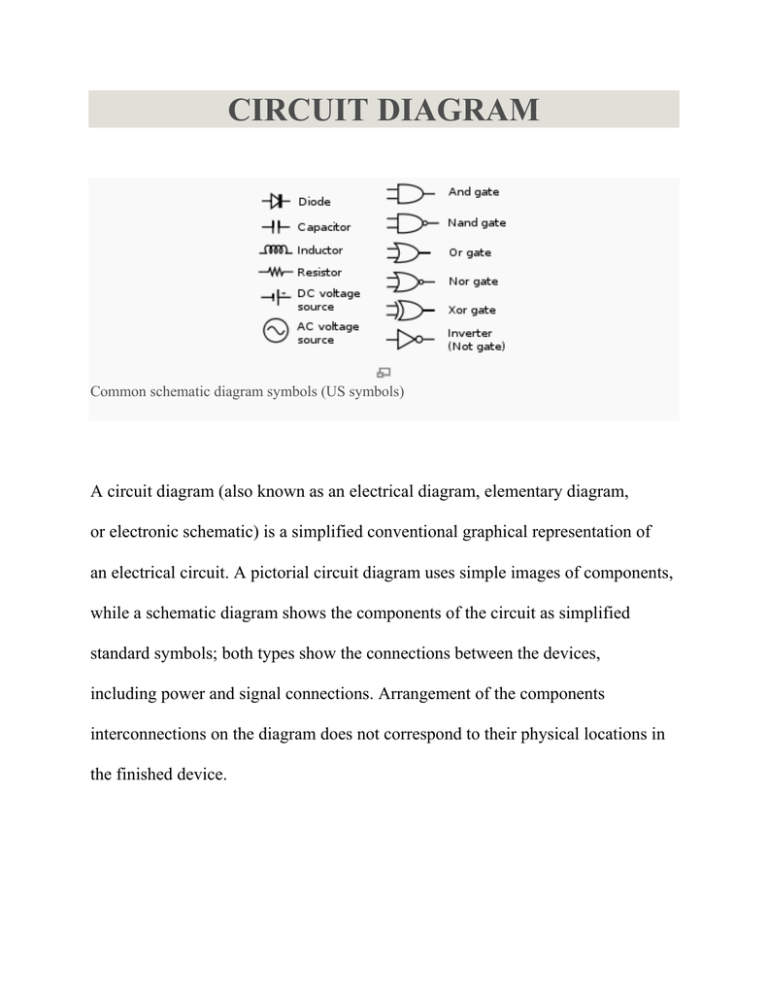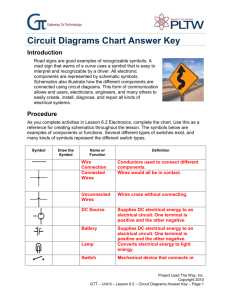CIRCUIT DIAGRAM
advertisement

CIRCUIT DIAGRAM Common schematic diagram symbols (US symbols) A circuit diagram (also known as an electrical diagram, elementary diagram, or electronic schematic) is a simplified conventional graphical representation of an electrical circuit. A pictorial circuit diagram uses simple images of components, while a schematic diagram shows the components of the circuit as simplified standard symbols; both types show the connections between the devices, including power and signal connections. Arrangement of the components interconnections on the diagram does not correspond to their physical locations in the finished device. Unlike a block diagram or layout diagram, a circuit diagram shows the actual wire connections being used. The diagram does not show the physical arrangement of components. A drawing meant to depict what the physical arrangement of the wires and the components they connect is called "artwork" or "layout" or the "physical design." Circuit diagrams are used for the design (circuit design), construction (such as PCB layout), and maintenance of electrical and electronic equipment. Symbols Circuit diagram symbols have differed from country to country and have changed over time, but are now to a large extent internationally standardized. Simple components often had symbols intended to represent some feature of the physical construction of the device. For example, the symbol for a resistor shown here dates back to the days when that component was made from a long piece of wire wrapped in such a manner as to not produce inductance, which would have made it a coil. These wirewound resistors are now used only in high-power applications, smaller resistors being cast from carbon composition (a mixture of carbon and filler) or fabricated as an insulating tube or chip coated with a metal film. The internationally standardized symbol for a resistor is therefore now simplified to an oblong, sometimes with the value in ohms written inside, instead of the zigzag symbol. A less common symbol is simply a series of peaks on one side of the line representing the conductor, rather than back-and-forth as shown here. Schematic wire junctions: 1. Old style: (a) connection, (b) no connection. 2. One CAD style: (a) connection, (b) no connection. 3. Alternative CAD Style: (a) connection, (b) no connection. The linkages between leads were once simple crossings of lines; one wire insulated from and "jumping over" another was indicated by it making a little semicircle over the other line. With the arrival of computerized drafting, a connection of two intersecting wires was shown by a crossing with a dot or "blob", and a crossover of insulated wires by a simple crossing without a dot. However, there was a danger of confusing these two representations if the dot was drawn too small or omitted. Modern practice is to avoid using the "crossover with dot" symbol, and to draw the wires meeting at two points instead of one. It is also common to use a hybrid style, showing connections as a cross with a dot while insulated crossings use the semicircle. On a circuit diagram, the symbols for components are labelled with a descriptor or reference designator matching that on the list of parts. For example, C1 is the first capacitor, L1 is the first inductor, Q1 is the first transistor, and R1 is the first resistor (note that this is not written as a subscript, as in R1, L1,…). Often the value or type designation of the component is given on the diagram beside the part, but detailed specifications would go on the parts list. Source: http://web.ua.es/docivis/magnet/circuit_diagram.html


